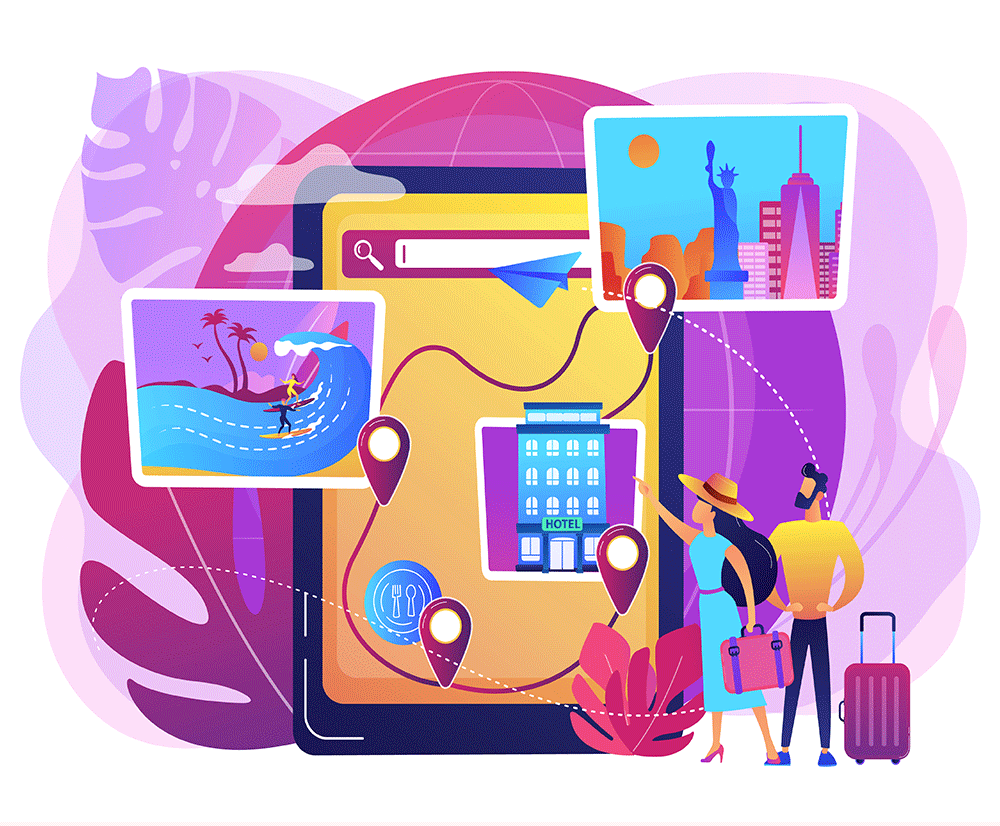How to Build a Next-Gen Travel App in GCC: Key Features, Cost & Development Process

Capitalize on the growing tourism market in the GCC by developing a next-generation travel app. Leveraging advanced technology can enhance traveler experiences and position your brand as a market leader. The Gulf Cooperation Council, comprising Saudi Arabia, the UAE, and Qatar, is undergoing significant transformation through initiatives like Saudi Vision 2030 and the UAE's Tourism Strategy 2040. With increasing tourism and a digitally engaged population, the GCC is evolving into a global travel hub. Investing in a next-gen travel app is a strategic decision to access this expanding market.
This guide is designed for forward-thinking entrepreneurs and enterprises looking to build a market-leading travel application. We will go beyond basic features to explore the advanced technology and strategic planning required to compete in this high-stakes environment, covering everything from key features and the development process to a transparent breakdown of costs.
Why Travel Apps Are Thriving in the GCC
The GCC travel and tourism market is expanding quickly, fueled by both international and domestic travelers. Valued at USD 70.46 billion in 2024, it is projected to reach USD 138.06 billion by 2033, with a 7.1% CAGR (IMARC Group). Key segments include leisure, business, and religious travel, each offering unique opportunities for targeted product strategies. Several factors contribute to this growth:
- Mega-Projects and Events: Initiatives such as Saudi Arabia’s NEOM, The Red Sea Project, Expo City Dubai, and major sporting events in Qatar are attracting tourists and reshaping regional travel. These developments require technology to manage complex itineraries and enhance visitor experiences.
- High Digital Adoption: The GCC boasts some of the highest smartphone penetration rates worldwide, with some countries exceeding 100%. Travelers expect seamless, mobile-first experiences and rely on their devices for booking, payments, and local recommendations, making a robust mobile app essential for engagement.
- The Unified GCC Tourist Visa: A long-awaited "Schengen-style" visa for the region is expected to be launched by the end of 2025. This single visa will allow tourists to travel across the six member states without applying for a separate visa for each country. This initiative is a game-changer, creating a unified travel market and an immense opportunity for apps that can facilitate cross-border itineraries, encouraging "Grand Tours" of the GCC.
The Architecture of a Next-Gen Travel App

A successful travel app in this market is not just a booking engine; it's a holistic travel companion. Its architecture must be robust, scalable, and built for a superior user experience. This requires a strategic mix of core and advanced features. The architecture should first and foremost serve key user goals to enhance the app's usability: seamlessly rebook a delayed flight within two taps, provide instant access to personalized travel recommendations, and offer real-time updates on itinerary changes. By focusing on these observable tasks, the app can deliver tangible benefits and connect technological choices to real user outcomes.
Core Features for a Travel App MVP (Minimum Viable Product)
- User Profile & Onboarding: A streamlined, secure registration process with options for social media login.
- Search & Filters: A powerful search engine for flights, hotels, and activities with granular filters (price, dates, ratings, amenities, etc.).
- Booking & Reservation System: A secure and reliable system for completing bookings directly within the app.
- Payment Gateway Integration: Secure integration with multiple payment methods, including credit/debit cards and local gateways.
- Push Notifications: Real-time alerts for booking confirmations, flight status, and itinerary changes.
Key Features of a Next-Gen Travel App
Once the MVP is established, a next-gen app expands into these more advanced, differentiating features:
- AI-Powered Recommendations & Personalization: This is where the magic happens. An AI engine can analyze a user's past bookings, location data, and browsing behavior to provide hyper-personalized suggestions. For a business traveler, it might suggest hotels near their meeting location with high-speed Wi-Fi. For a family, it could recommend kid-friendly activities and restaurants. This goes far beyond simple filters, making the app feel like a personal concierge.
- Multi-Language & Multi-Currency Support: Given the international and diverse nature of the GCC, multilingual support is critical. While English is common, native Arabic language support with right-to-left (RTL) text formatting is a non-negotiable for targeting the local population. The app must also support all major currencies in the region (AED, SAR, QAR) with real-time conversion rates.
- Real-Time Flight/Hotel Data Integration: This is a cornerstone of reliability. The app must integrate with global distribution systems (GDS) and third-party APIs like Amadeus and Sabre to provide real-time updates on flight status, gate changes, and hotel availability. This reduces user anxiety and builds trust.
- AR/VR Travel Previews: To truly stand out, offer a glimpse into the experience. Augmented Reality (AR) features can allow users to point their phone at a real-world location and see overlaid information about nearby restaurants or attractions. Virtual Reality (VR) can provide immersive 360-degree tours of hotel rooms or tour destinations, helping users make more informed decisions.
- Smart In-App Payments & Wallet Integration: A secure and frictionless payment process is paramount. Beyond standard credit cards, the app should integrate with local payment gateways like Mada in Saudi Arabia and Benefit in Bahrain. Implementing an in-app wallet or loyalty points system encourages repeat usage and builds a strong customer base.
- Gamification & Loyalty Programs: Engage users with fun, interactive elements. Reward them for visiting new cities, leaving reviews, or booking with exclusive badges, discounts, or loyalty points. This not only increases user retention but also transforms the travel experience into a journey of discovery.
The Travel App Development Process: A Strategic Roadmap

Building a sophisticated travel app is a structured, multi-stage journey. This detailed GCC app development process provides a roadmap for turning your vision into a reality.
1. Discovery & Strategy
This initial phase is about defining the project's DNA. It involves in-depth market research to identify your target audience's specific needs and pain points. You will analyze top competitors like Booking.com, Wego, and Skyscanner to identify their strengths and weaknesses. This phase culminates in a clear business plan, a detailed product roadmap, and a finalized monetization strategy (e.g., commission-based, subscription, or freemium model).
2. UI/UX Design
First impressions matter. The design phase is where your app’s user interface (UI) and user experience (UX) are meticulously crafted. The design must be intuitive, visually appealing, and tailored to the preferences of the GCC market, which values elegance and ease of use. This stage produces wireframes, mockups, and interactive prototypes that map out every user journey, from search to checkout.
3. Back-end & Front-end Development
This is the core of the mobile app for travel industry development.
- Back-end: The back-end is the server-side foundation that handles data storage, security, and logic. A robust back-end is crucial for handling large volumes of user data and transactions. A microservices architecture is often recommended for scalability.
- Front-end: The front-end is what the user sees and interacts with. For a travel app, the choice between native (iOS/Android) and cross-platform development is a major decision.
- Cross-Platform (e.g., Flutter or React Native): This is often the more cost-effective choice as a single codebase can be used for both iOS and Android, significantly reducing development time and cost.
- Native (e.g., Swift for iOS, Kotlin for Android): Native development offers superior performance and a more polished user experience, but it requires two separate teams and a larger budget.
4. API Integration
The heart of a travel app lies in its ability to connect to external services. This stage involves integrating with various APIs for:
- Flights & Hotels: GDS like Amadeus and Sabre are essential for live data.
- Payments: Securely connecting to local and international payment gateways.
- Maps & Geolocation: Using APIs like Google Maps or Mapbox to provide navigation and location-based services.
- Reviews & Social: Integrating with platforms like TripAdvisor to display user-generated content.
5. Quality Assurance (QA) & Testing
Before launch, the app undergoes rigorous testing to ensure it's bug-free, secure, and performs flawlessly under various conditions. This includes:
- Functional Testing: Verifying that all features work as intended.
- Performance Testing: Ensuring the app remains responsive under high user load.
- Security Testing: Protecting sensitive user data with robust encryption and security protocols.
- Usability Testing: Gathering feedback from real users to refine the user experience.
6. Launch & Post-Launch Support
After successful testing, the app is submitted to the Apple App Store and Google Play Store. The work doesn't stop at launch. Ongoing maintenance, bug fixes, feature updates based on user feedback, and performance monitoring are crucial for the app's long-term success.
Travel App Development Cost in GCC: A Detailed Breakdown

The travel app development cost in GCC is a primary concern for businesses. It's not a fixed number; it's a range that depends on several key factors.
Factors Influencing the Cost
- Features & Complexity: This is the single biggest cost driver. An MVP with basic booking features will be significantly cheaper than a full-fledged, next-gen app with AI, AR, and extensive third-party integrations.
- UI/UX Design: A custom, elegant design tailored for the GCC market will cost more than using a generic template.
- Platform Choice: As mentioned, cross-platform development (Flutter, React Native) can reduce costs by 30-40% compared to native development.
- Development Team Location: The hourly rate of developers is the most variable factor. While local teams in the GCC (UAE, Saudi Arabia) offer closer collaboration, they come with a higher price tag. Many businesses choose to outsource to regions with competitive rates, such as India or Eastern Europe.
The Cost Breakdown
While a precise figure requires a detailed consultation, we can provide a realistic range based on the scope of the project. The estimates below are based on a balanced approach of high-quality development, with a team from a competitive outsourcing market.
Note: The total cost for a next-gen app can exceed $350,000 depending on the complexity of AI/ML models, AR/VR content, and backend infrastructure.
Final Thoughts: The Future of Travel in the GCC
The GCC's digital transformation presents a golden opportunity for businesses ready to invest in innovative travel technology. By building a next-gen travel app that focuses on a seamless, localized, and intelligent user experience, you can create a powerful brand that captures and retains the loyalty of millions of travelers. The journey from idea to a successful app requires meticulous planning, a focus on key features, and a clear understanding of the travel app cost in GCC and its development lifecycle.
Ready to turn your vision into a reality? Our team of expert developers and strategists specializes in creating high-performance, next-gen travel apps tailored for the GCC market. Want to build a future-ready travel app? Contact us today for a tailored consultation and a precise cost estimate.
